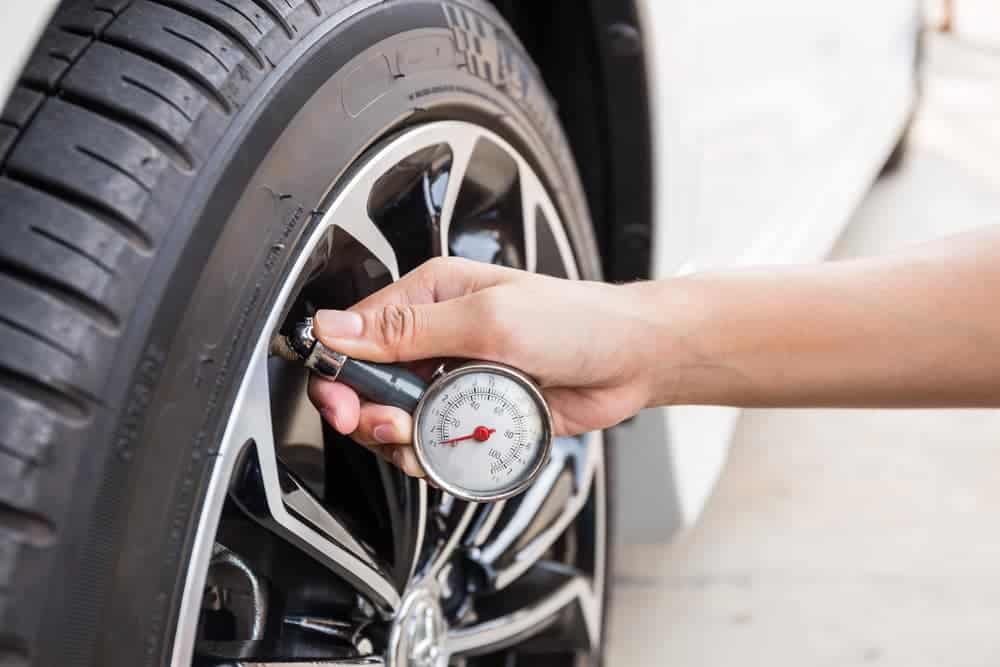Tires and tire pressure are possibly the most critical safety features, aside from the braking system. Maintaining proper tire pressure is one of the most effective strategies to avoid tire problems. For example, this post will go through how to check the tire pressure in your historic automobile restomod in detail.
So, how do you check the tire pressure on a restomod classic car? Well, the following are the six stages to checking tire pressure: Purchase a tire pressure gauge, inspect your tires before driving, insert the tire pressure gauge into the valve and measure psi, compare the measured psi to the psi sticker on your door, then inflate/deflate the two until they are properly paired.
Safety, Saftey, Safety
According to the National Highway Traffic Safety Administration Driving on under-inflated tires is one of the biggest causes of tire failure, and not having enough air in your tires presents many other problems. As a result, they wear out more rapidly, handle poorly and reduce fuel efficiency.
In addition, over-inflated tires are more susceptible to damage from road irregularities, and this also creates a bumpier ride. Overfilling your tires is just as dangerous as under-filling them. Monthly pressure checks on all tires, including the spare (or before a long trip).
How to Check Tire Pressure
Tires have been known to lose up to 1psi (pounds per square inch) every month, so check all tires, including your spare, once a month (or before a long trip). It’s easy. Here’s how (cliff notes version):
- Purchase a tire pressure gauge
- Check your tires before driving on them
- Insert tire pressure gauge into the valve and measure psi
- Compare the measured psi to the psi sticker on your door
- Then inflate/deflate so they match are paired perfectly.
Tire Pressure Gauges
When it comes to choosing a gauge, you typically have 3 options:
- Pen-type pressure gauges – Have a ruler-like rod that slides in and out of a sleeve to measure air pressure
- Dial pressure gauges – Feature a numbered dial with a watch-like hand
- Digital pressure gauges – Display numbers on a digital screen
Put the pressure gauge into the valve stem, making sure the gauge is evenly and firmly pressed onto the stem. If using a pen-style gauge, read the number on the rod that pops out of the sleeve. Read dial pressure gauges like you would a watch with one hand.
With a digital pressure gauge, simply read the number on the screen. Don’t check your tire pressure more than once, since air can escape through the valve stem on subsequent readings.
Find Tire PSI

Find your tires’ recommended PSI (pounds per square inch) in the owner’s manual or on a sticker just inside the driver’s side door. The proper PSI is crucial to your safety and the car’s longevity. Under-inflated tires can overheat and wear unevenly; over-inflated tires can blow out.
For an accurate PSI reading make sure to check tire pressure when tires are cold. The outside temperature can actually change your tire pressure, so re-check your PSI every few weeks for any time you notice a change in tire performance. This will help to ensure maximum safety. Take your car to a mechanic you trust for a professional assessment
What is the Right Tire Pressure?
Since maintaining your tires is so important to your safety and your car’s overall performance, it’s important to know what tire pressure is right for your vehicle. PSI measures tire air pressure; 30 to 35 PSI is optimal.
PSI measures tire air pressure; 30 to 35 PSI is optimal. Depending on the vehicle, this label may be on the edge of the vehicle’s door, on the doorpost or in the glove box. The label will usually give recommendations for the front and rear tires as well as the spare, and it’s important you stick to those guidelines. (While you’re at it, check the air in your spare tire, too. It loses air pressure over time.)
Guidelines
Even after you’ve replaced your tires, the same pressure guidelines on your car’s label apply to new tires of the same size. If your tires are larger than the stock models that came on your car and you’re unsure of the recommended PSI, check the tire’s sidewall to find the maximum cold PSI level.
Pressure recommendations are based on readings taken from a tire pressure gauge. Check the pressure first thing in the morning or wait at least three hours after driving; this provides sufficient time for them to cool back down.
How to Maintain Proper Tire Pressure?
Having a detailed understanding of your recommended psi levels is a great place to start. Now, the challenge will be to remember to check the tire pressure on a consistent basis. There is some debate on how frequently you should check tire pressure. Some experts recommend you check the air pressure every time you refuel; others say once a month is sufficient. The car’s tire pressure monitoring system checks tire pressure.
In terms of tire pressure checking frequency, the outlook in the US is not good. With many people driving new cars fewer people are checking their tire pressure regularly. Classic car folks are probably as good as this as anyone. Moreover, their cars aren’t equipped with tire pressure monitoring systems. However, restomods owners with modern engines and systems are starting to take tire pressure monitoring for granted as well.
Check PSI Often
Frequently checking your PSI becomes even more important in the fall and winter, when outside temperatures drop and weather conditions fluctuate causing your tires to lose air more quickly. Generally speaking, your tire will gain or lose one PSI for every 10-degree change in temperature, which means if you have a sudden drop of 30 degrees, you could lose three PSI overnight. If your tires were already low, this could cause tire damage, steering problems or even a flat tire.
Tire Pressure According to the National Highway Traffic Safety Administration?
The National Highway Traffic Safety Authority (NHTSA) conducted a few surveys to determine how often the American people check their tire pressure. In its final ruling, the agency adds that it seems likely that respondents in both polls overestimated how often they check tire pressure. Moreover, these surveys were performed during tire failure news.
Knowing and maintaining the right air pressure is important to the safety and longevity of your tires. All it takes is a tire pressure gauge and a few minutes of your time.
Once you have the right tire pressure, make sure you also have the right coverage. So, learn more about how Nationwide auto insurance can help protect you and save you money.
Related Questions
Go to a gas station that has an air machine for filling tires. Pick one tire to start with and locate the PSI label on the tire, remove the tire air stem cap, pull the air hose over to the tire, read the pressure bar to see the current PSI level in your tire.
You can learn how to check tire pressure without a gauge by practicing with and without a gauge. When measuring tire pressure by hand, you can simply push the tip of your thumb into the side of the tire. Then, compare your measurements with actual measurements from a gauge. The more you practice what low, medium and high tire pressures are, the better prepared you’ll be in the event your traveling without your tire pressure gauge.
The first thing to do is determine the correct amount of air much air should be in your tires. You will find this information printed on a sticker on the inside of the driver’s side door or in the owner’s manual. In the event you can’t find it, be sure to look inside the glove box door or fuel door. Lastly, if all else fails, look at the writing on the side of your tires.
You will know if your put too much air into your tires by comparing the measured PSI level relative to the manufactures specification. On newer vehicles, the recommended tire pressure is usually listed on a sticker inside the driver’s door. On an older car or even a newer one without a sticker on the door, you can usually find the recommended psi level in the owner’s manual. In the event you have no information, use a range from 32 psi to 35 psi in the tires when they’re cold.


